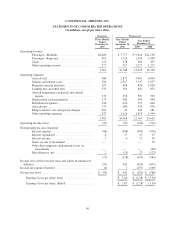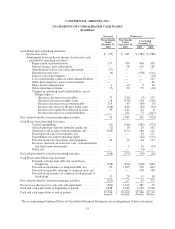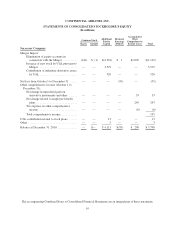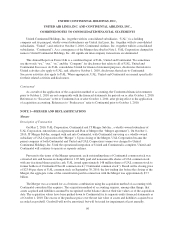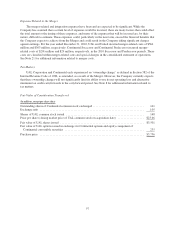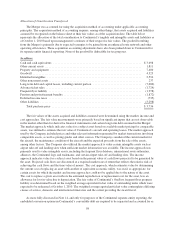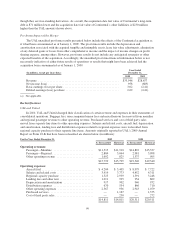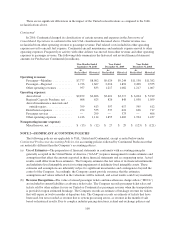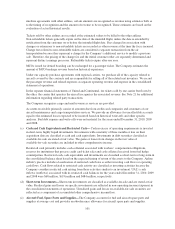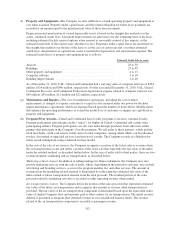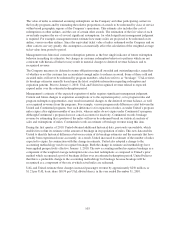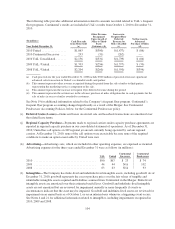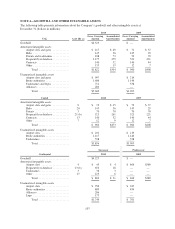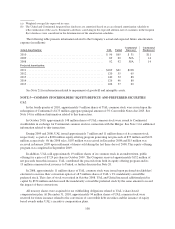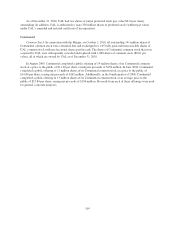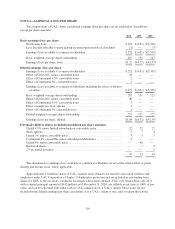United Airlines 2010 Annual Report Download - page 102
Download and view the complete annual report
Please find page 102 of the 2010 United Airlines annual report below. You can navigate through the pages in the report by either clicking on the pages listed below, or by using the keyword search tool below to find specific information within the annual report.
There are no significant differences in the impact of the United reclassifications as compared to the UAL
reclassifications above.
Continental
In 2010, Continental changed its classification of certain revenue and expenses in the Statements of
Consolidated Operations to conform to the new UAL classification discussed above. Charter revenue was
reclassified from other operating revenue to passenger revenue. Fuel related costs included in other operating
expense moved to aircraft fuel expense. Continental aircraft maintenance and materials expense moved to other
operating expenses. Frequent flyer activity with other airlines was moved from other revenue and other operating
expenses to passenger revenue. The following table summarizes the historical and revised financial statement
amounts for Predecessor Continental (in millions).
Nine Months Ended
September 30, 2010
Year Ended
December 31, 2009
Year Ended
December 31, 2008
As
Reclassified Historical
As
Reclassified Historical
As
Reclassified Historical
Operating revenues:
Passenger—Mainline ............. $7,777 $8,002 $9,024 $9,244 $11,138 $11,382
Passenger—Regional ............. 1,726 1,667 2,016 1,894 2,498 2,355
Other operating revenues .......... 957 833 1,217 1,082 1,217 1,007
Operating expenses:
Aircraft fuel .................... $2,872 $2,806 $3,401 $3,317 $ 6,004 $ 5,919
Regional Capacity Purchase, net .... 608 625 826 848 1,038 1,059
Aircraft maintenance materials and
outside repairs ................. 399 413 597 617 595 612
Distribution expenses ............. 474 555 537 624 626 717
Passenger services ............... — 299 — 373 — 406
Other operating expenses .......... 1,416 1,114 1,855 1,402 1,994 1,437
Nonoperating income (expense):
Miscellaneous, net ............... $ (13) $ (12) $ 27 $ 29 $ (123) $ (121)
NOTE 2—SIGNIFICANT ACCOUNTING POLICIES
The following policies are applicable to UAL, United and Continental, except as noted below under
Continental Predecessor Accounting Policies, for accounting policies followed by Continental Predecessor that
are materially different than the Company’s accounting policies.
(a) Use of Estimates—The preparation of financial statements in conformity with accounting principles
generally accepted in the United States of America (“GAAP”) requires management to make estimates and
assumptions that affect the amounts reported in these financial statements and accompanying notes. Actual
results could differ from those estimates. The Company estimates the fair value of its financial instruments
and indefinite-lived intangible assets for testing impairment of indefinite-lived intangible assets. These
estimates and assumptions are inherently subject to significant uncertainties and contingencies beyond the
control of the Company. Accordingly, the Company cannot provide assurance that the estimates,
assumptions and values reflected in the valuations will be realized, and actual results could vary materially.
(b) Revenue Recognition—The value of unused passenger tickets and miscellaneous charge orders (“MCOs”)
are included in current liabilities as advance ticket sales. The Company records passenger ticket sales and
tickets sold by other airlines for use on United or Continental as passenger revenue when the transportation
is provided or upon estimated breakage. The Company records an estimate of breakage revenue for tickets
that will expire in twelve months at departure date. The Company records an estimate of tickets that have
been used, but not recorded as revenue due to system processing errors, as revenue in the month of sale
based on historical results. Due to complex industry pricing structures, refund and exchange policies and
100


